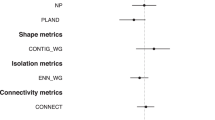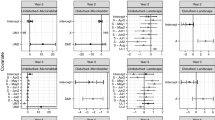Abstract
Odonates contribute highly to global biodiversity and are considered good indicators of environmental quality, but they are under-studied and quantitative information on their habitat associations is lacking. Our objective was to examine the effects of landscape configuration on site occupancy and movement dynamics of four odonate species in Iowa: Tramea onusta, Epitheca princeps, Pantala flavescens, and Calopteryx maculata. We conducted standardized visual encounter surveys for odonates at 233 public properties in Iowa from 2007 to 2011 and computed landscape variables within a 200, 600 m, and 1 km radius of each surveyed site. Using a robust design occupancy model in Program MARK, we estimated detection probability and site occupancy, site extinction, and site colonization probabilities for each species. We found few significant effects of landscape variables on site occupancy, extinction, or colonization, although landscape variables at 600 m were included in the best model for all species. Detection probability (SE) ranged from 0.30 (0.04) for Pantala flavescens to 0.49 (0.04) for Calopteryx maculata. Our study provides information to aid habitat restoration and management efforts on sites having suitable characteristics in the surrounding landscape and ultimately help conserve odonates.



Similar content being viewed by others
References
Angelibert S, Giani N (2003) Dispersal characteristics of three Odonate species in a patchy habitat. Ecog 26:13–20
Beyer HL (2012) Geospatial Modelling Environment version 0.7.2.1. http://www.spatialecology.com/gme. Accessed 13 March 2013
Bilton DT, Freeland JR, Okamura B (2001) Dispersal in freshwater invertebrates. Annu Rev Ecol Syst 32:159–181
Brady MJ, McAlpine CA, Possingham HP, Miller CJ, Baxter GS (2011) Matrix is important for mammals in landscapes with small amounts of native forest habitat. Landsc Ecol 26:617–628
Burnham KP, Anderson DR (2002) Model selection and multimodal inference: a practical information-theoretic approach. Springer, New York
Clausnitzer V, Kalkman VJ, Ram M et al (2009) Odonata enter the biodiversity crisis debate: the first global assessment of an insect group. Biol Conserv 142:1864–1869
Conrad KF, Willson KH, Harvey IF, Thomas CJ, Sherratt TN (1999) Dispersal characteristics of seven Odonate species in an agricultural landscape. Ecog 22:524–531
Corbet PS (1999) Dragonflies: behavior and ecology of Odonata. Cornell University Press, Ithaca
Cruden BW, Gode OJ (2000) The Odonata of Iowa. Bull Am Odonatol 6:13–48
Dolný A, Mižičová H, Harabiš F (2013) Natal philopatry in four European species of dragonflies (Odonata: Sympetrinae) and possible implications for conservation management. J Insect Conserv 17:821–829
Environmental Services Research Institute (2010) ArcGIS version 10. http://www.esri.com Accessed 30 Aug 2012
Fincke OM (1992) Interspecific competition for tree boles: consequences for mating systems and coexistence in Neotropical damselflies. Am Nat 139:80–101
Fischer C, Thies C, Tscharntke T (2011) Small mammals in agricultural landscapes: opposing responses to farming practices and landscape complexity. Biol Conserv 144:1130–1136
Fletcher RJ, Koford RR (2002) Habitat and landscape associations of breeding birds in native and restored grasslands. J Wildl Manag 66:1011–1022
Galatowitsch SM, Van Der Valk AG (1996) Characteristics of recently restored wetlands in the prairie pothole region. Wetl 16:75–83
Gibbons LK, Reed JM, Chew FS (2002) Habitat requirements and local persistence of three damselfly species (odonata: coenagrionidae). J Insect Conserv 6:47–55
Gu W, Swihard RK (2004) Absent or undetected? Effects of non-detection of species occurrence on wildlife-habitat models. Biol Conserv 116:195–203
Hamer TL, Flather CH, Noon BR (2006) Factors associated with grassland bird species richness: the relative roles of grassland area, landscape structure, and prey. Landsc Ecol 21:569–583
Hanson MA, Riggs MR (1995) Potential effects of fish predation on wetland invertebrates: a comparison of wetlands with and without Fathead Minnows. Wetl 15:167–175
Herkert JR (1994) The effects of habitat fragmentation on Midwestern grassland bird communities. Ecol Appl 4:461–471
International Union for Conservation and Nature (2012) IUCN Red List of Threatened Species, Version 2012.2. http://www.iucnredlist.org. Accessed 27 Feb 2013
Iowa Odonata Survey (2013) http://www.iowaodes.org. Accessed 16 April 2013
Jonsen ID, Taylor PD (2000) Fine-scale movement behaviors of calopterygid damselflies are influenced by landscape structure: an experimental manipulation. Oikos 88:553–562
Joyal LA, McCollough M, Hunter ML Jr (2002) Landscape ecology approaches to wetland species conservation: a case study of two turtle species in southern Maine. Conserv Biol 15:1755–1762
Kadoya T, Suda S, Tsubaki Y, Washitani I (2008) The sensitivity of dragonflies to landscape structure differs between life-history groups. Landsc Ecol 23:149–158
Kollasch RP (2004) Land cover of the State of Iowa in the Year 2002. Iowa Department of Natural Resources, Geological Survey, Des Moines
Lee Foote A, Rice Hornung CL (2005) Odonates as biological indicators of grazing effects on Canadian prairie wetlands. Ecol Entomol 30:273–283
MacKenzie DI, Nichols JD, Lachman GB, Droege S, Royle JA, Langtimm CA (2002) Estimating site occupancy rates when detection probabilities are less than one. Ecol 83:2248–2255
MacKenzie DI, Nichols JD, Hines JE, Knutson MG, Franklin AB (2003) Estimating site occupancy, colonization, and local extinction when a species is detected imperfectly. Ecol 84:2200–2207
McCauley SJ (2006) The effects of dispersal and recruitment limitation on community structure of odonates in artificial ponds. Ecog 29:585–595
McGarigal K, Cushman SA, Neel MC, Ene E (2002) FRAGSTATS: spatial pattern analysis program for categorical maps. Computer software program produced by authors, University of Massachusetts, Amherst. http://www.umass.edu/landeco/research/fragstats/fragstats.htm. Accessed 13 March 2013
McPeek MA (1989) Differential dispersal tendencies among Enallagma damselflies (Odonata) inhabiting different habitats. Oikos 56:187–195
Michiels NK, Dhondt AA (1991) Characteristics of dispersal in sexually mature dragonflies. Ecol Entomol 16:449–459
Morrison ML, Marmot BG, Mannan RW (2006) Wildlife habitat relationships: concepts and applications. Island Press, Washington
Olson GS, Anthony RG, Forsman ED et al (2005) Modeling of site occupancy dynamics for Northern Spotted Owls, with an emphasis on the effects of Barred Owls. J Wildl Manag 69:918–932
Paulson D (2011) Dragonflies and damselflies of the East. Princeton University Press, Princeton
Pither J, Taylor PD (1998) An experimental assessment of landscape connectivity. Oikos 83:166–174
Prior JC (1991) Landforms of Iowa. University of Iowa Press, Iowa City
Ribic CA, Sample DW (2001) Associations of grassland birds with landscape factors in southern Wisconsin. Am Midl Nat 146:105–121
Roush SA, Anon JP (2003) Repopulation of restored wetland habitat by Odonata (dragonflies and damselflies). Ecol Restor 21:174–179
Thomas CD, Cameron A, Green RE et al (2004) Extinction risk from climate change. Nat 427:287–301
Westfall MJ, May ML (2006) Damselflies of North America. Scientific Publishers, Gainesville
White GC, Burnham KP (1999) Program MARK: survival estimation from populations of marked animals. Bird Study 46:120–139
Zohrer JJ (2006) The Iowa comprehensive wildlife action plan. Iowa Department of Natural Resources, Des Moines
Acknowledgments
This project was funded by various State Wildlife Grants (T-6-R-1, T-6-R-2, T-6-R-3, T-6-R-4, and T-6-R-5) and a Landowner Incentive Program Grant under the U.S. Fish and Wildlife Service Wildlife and Sport Fish Restoration Program. This project would not be possible without the assistance of P. Frese with the Iowa Department of Natural Resources. Special thanks to several field technicians for collecting data and staff with the Iowa Department of Natural Resources for logistical support. Staff with the U.S. Fish and Wildlife Service and various County Conservation Boards across Iowa also provided logistical assistance and allowed access to their properties. Private landowners enrolled in the Landowner Incentive Program also allowed access to their properties.
Author information
Authors and Affiliations
Corresponding author
Rights and permissions
About this article
Cite this article
Harms, T.M., Kinkead, K.E. & Dinsmore, S.J. Evaluating the effects of landscape configuration on site occupancy and movement dynamics of odonates in Iowa. J Insect Conserv 18, 307–315 (2014). https://doi.org/10.1007/s10841-014-9638-4
Received:
Accepted:
Published:
Issue Date:
DOI: https://doi.org/10.1007/s10841-014-9638-4




